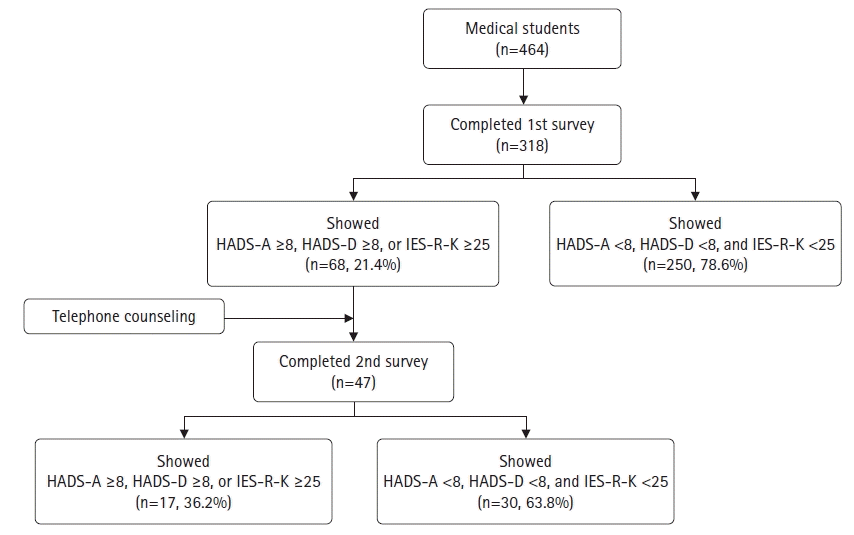1. Seo WS, Kim SH, Song SY, Hur J, Lee J, Choi S, et al. Yeungnam University type drive-through (YU-Thru) coronavirus disease 2019 (COVID-19) screening system: a rapid and safe screening system. Yeungnam Univ J Med. 2020; 37:349–55.

2. Lee DH, Kim JY, Kang HS. The emotional distress and fear of contagion related to Middle East respiratory syndrome (MERS) on general public in Korea. Korean J Psychol Gen. 2016; 35:355–83.

3. Lee DH, Kim YJ, Lee DH, Hwang HH, Nam SK, Kim JY. The influence of public fear, and psycho-social experiences during the coronavirus disease 2019 (COVID-19) pandemic on depression and anxiety in South Korea. Korean J Couns Psychother. 2020; 32:2119–56.
4. Cao W, Fang Z, Hou G, Han M, Xu X, Dong J, et al. The psychological impact of the COVID-19 epidemic on college students in China. Psychiatry Res. 2020; 287:112934.

5. Wathelet M, Duhem S, Vaiva G, Baubet T, Habran E, Veerapa E, et al. Factors associated with mental health disorders among university students in France confined during the COVID-19 pandemic. JAMA Netw Open. 2020; 3:e2025591.

6. Ma Z, Zhao J, Li Y, Chen D, Wang T, Zhang Z, et al. Mental health problems and correlates among 746 217 college students during the coronavirus disease 2019 outbreak in China. Epidemiol Psychiatr Sci. 2020; 29:e181.

7. Chang J, Yuan Y, Wang D. Mental health status and its influencing factors among college students during the epidemic of COVID-19. Nan Fang Yi Ke Da Xue Xue Bao. 2020; 40:171–6.
8. Campos R, Pinto V, Alves D, Rosa CP, Pereira H. Impact of COVID-19 on the mental health of medical students in Portugal. J Pers Med. 2021; 11:986.

9. Kwak DI, Choi YK, Lim HJ, Oh HJ, Jung IK, Lee MS. A study on the stress, copying and general well-being of medical students. Korean J Med Educ. 2000; 12:227–39.

10. Arulampalam W, Naylor RA, Smith JP. Dropping out of medical school in the UK: explaining the changes over ten years. Med Educ. 2007; 41:385–94.

11. O’Neill LD, Wallstedt B, Eika B, Hartvigsen J. Factors associated with dropout in medical education: a literature review. Med Educ. 2011; 45:440–54.

12. Guthrie EA, Black D, Shaw CM, Hamilton J, Creed FH, Tomenson B. Embarking upon a medical career: psychological morbidity in first year medical students. Med Educ. 1995; 29:337–41.

13. Guthrie E, Black D, Bagalkote H, Shaw C, Campbell M, Creed F. Psychological stress and burnout in medical students: a five-year prospective longitudinal study. J R Soc Med. 1998; 91:237–43.

14. Dyrbye LN, Thomas MR, Shanafelt TD. Systematic review of depression, anxiety, and other indicators of psychological distress among U.S. and Canadian medical students. Acad Med. 2006; 81:354–73.

15. Hill CE, Sim W, Spangler P, Stahl J, Sullivan C, Teyber E. Therapist immediacy in brief psychotherapy: case study II. Psychotherapy (Chic). 2008; 45:298–315.

16. Oh SM, Min KJ, Park DB. A study on the standardization of the hospital anxiety and depression scale for Koreans. J Korean Neuropsychiatr Assoc. 1999; 38:289–96.
17. Eun HJ, Kwon TW, Lee SM, Kim TH, Choi MR, Cho SJ. A study on reliability and validity of the Korean version of impact of event scale-revised. J Korean Neuropsychiatr Assoc. 2005; 44:303–10.
18. Weiss D, Marmar CR. The impact of event scale-revised. In : Wilson J, Keane TM, editors. Assessing psychological trauma and PTSD: a practitioner’s handbook. New York: Guildford Press;1997. p. 399–411.
19. Jeong J, Lee SJ. Research trend on depression of Korean medical students based on quantitative studies. J Korea Contents Assoc. 2021; 21:446–57.
20. Lee KH, Ko Y, Kang KH, Lee HK, Kang J, Hur Y. Mental health and coping strategies among medical students. Korean J Med Educ. 2012; 24:55–63.

21. Jo SH, Koo BH, Seo WS, Yun SH, Kim HG. The psychological impact of the coronavirus disease pandemic on hospital workers in Daegu, South Korea. Compr Psychiatry. 2020; 103:152213.

22. Liu Z, Liu R, Zhang Y, Zhang R, Liang L, Wang Y, et al. Association between perceived stress and depression among medical students during the outbreak of COVID-19: the mediating role of insomnia. J Affect Disord. 2021; 292:89–94.

23. Romic I, Silovski H, Mance M, Pavlek G, Petrovic I, Figl J, et al. Psychological effects of "double crisis" (COVID-19 pandemic and earthquakes) on Croatian medical students. Psychiatr Danub. 2021; 33(Suppl 10):120–5.
24. Hill CE. Helping skills: facilitating exploration, insight, and action. 2nd ed. Washington, DC: American Psychological Association;2004.
25. Kim JH, Lee HJ. The recognition and counseling performance factors of university students who experienced phone counseling: focused on university students in Gyeongsangnam-do. Korean J Couns Case Stud Pract. 2021; 6:1–17.
26. Yoo HR, Kim S, Park CS, Kim JA. Perception and satisfaction of healthcare providers at hospitals on temporarily permitted telephone counseling during COVID-19 pandemic. HIRA Res. 2021; 1:36–49.

27. Mheidly N, Fares MY, Fares J. Coping with stress and burnout associated with telecommunication and online learning. Front Public Health. 2020; 8:574969.

28. Zis P, Artemiadis A, Bargiotas P, Nteveros A, Hadjigeorgiou GM. Medical studies during the COVID-19 pandemic: the impact of digital learning on medical students’ burnout and mental health. Int J Environ Res Public Health. 2021; 18:349.

29. Kim Y, Lee YH. Creativity in medical education: concepts related to creative capacity. Yeungnam Univ J Med. 2020; 37:79–83.





 PDF
PDF Citation
Citation Print
Print




 XML Download
XML Download